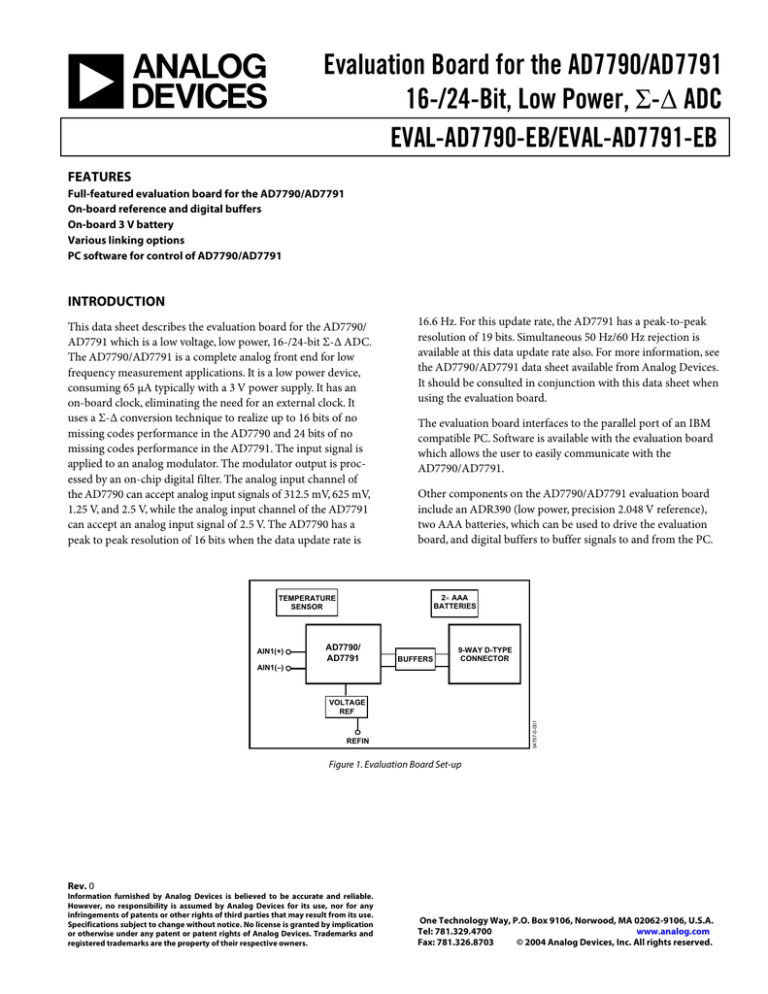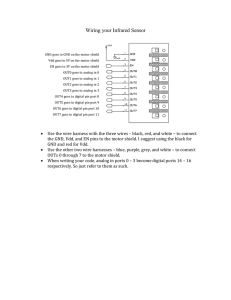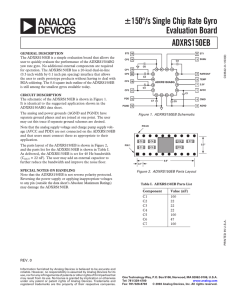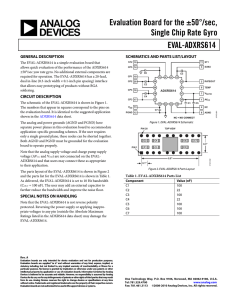
Evaluation Board for the AD7790/AD7791
16-/24-Bit, Low Power, Σ-∆ ADC
EVAL-AD7790-EB/EVAL-AD7791-EB
FEATURES
Full-featured evaluation board for the AD7790/AD7791
On-board reference and digital buffers
On-board 3 V battery
Various linking options
PC software for control of AD7790/AD7791
INTRODUCTION
This data sheet describes the evaluation board for the AD7790/
AD7791 which is a low voltage, low power, 16-/24-bit Σ-Δ ADC.
The AD7790/AD7791 is a complete analog front end for low
frequency measurement applications. It is a low power device,
consuming 65 µA typically with a 3 V power supply. It has an
on-board clock, eliminating the need for an external clock. It
uses a Σ-Δ conversion technique to realize up to 16 bits of no
missing codes performance in the AD7790 and 24 bits of no
missing codes performance in the AD7791. The input signal is
applied to an analog modulator. The modulator output is processed by an on-chip digital filter. The analog input channel of
the AD7790 can accept analog input signals of 312.5 mV, 625 mV,
1.25 V, and 2.5 V, while the analog input channel of the AD7791
can accept an analog input signal of 2.5 V. The AD7790 has a
peak to peak resolution of 16 bits when the data update rate is
16.6 Hz. For this update rate, the AD7791 has a peak-to-peak
resolution of 19 bits. Simultaneous 50 Hz/60 Hz rejection is
available at this data update rate also. For more information, see
the AD7790/AD7791 data sheet available from Analog Devices.
It should be consulted in conjunction with this data sheet when
using the evaluation board.
The evaluation board interfaces to the parallel port of an IBM
compatible PC. Software is available with the evaluation board
which allows the user to easily communicate with the
AD7790/AD7791.
Other components on the AD7790/AD7791 evaluation board
include an ADR390 (low power, precision 2.048 V reference),
two AAA batteries, which can be used to drive the evaluation
board, and digital buffers to buffer signals to and from the PC.
2× AAA
BATTERIES
TEMPERATURE
SENSOR
AIN1(+)
AD7790/
AD7791
BUFFERS
9-WAY D-TYPE
CONNECTOR
AIN1(–)
04797-0-001
VOLTAGE
REF
REFIN
Figure 1. Evaluation Board Set-up
Rev. 0
Information furnished by Analog Devices is believed to be accurate and reliable.
However, no responsibility is assumed by Analog Devices for its use, nor for any
infringements of patents or other rights of third parties that may result from its use.
Specifications subject to change without notice. No license is granted by implication
or otherwise under any patent or patent rights of Analog Devices. Trademarks and
registered trademarks are the property of their respective owners.
One Technology Way, P.O. Box 9106, Norwood, MA 02062-9106, U.S.A.
Tel: 781.329.4700
www.analog.com
Fax: 781.326.8703
© 2004 Analog Devices, Inc. All rights reserved.
EVAL-AD7790-EB/EVAL-AD7791-EB
TABLE OF CONTENTS
Hardware Description...................................................................... 3
Software Requirements and Installation ....................................5
Power Supplies .............................................................................. 3
Using the Evaluation Board Interface.........................................6
Link Options ................................................................................. 3
Schematic and Components ............................................................9
Setup Conditions .......................................................................... 3
Component Listing .................................................................... 10
Evaluation Board Interfacing...................................................... 4
Ordering Guide .......................................................................... 12
Sockets ........................................................................................... 4
ESD Caution................................................................................ 12
Software Description........................................................................ 5
REVISION HISTORY
6/04—Revision 0: Initial Version
Rev. 0 | Page 2 of 12
EVAL-AD7790-EB/EVAL-AD7791-EB
HARDWARE DESCRIPTION
POWER SUPPLIES
LK3–LK4
Two AAA batteries are provided with the evaluation board.
These can be used to supply VDD to the complete board.
Alternatively, an external 3 V or 5 V supply can be used using
Terminal J5 or via Connector J7. The battery/external power
supply provides the VDD for the reference, ADC, and buffers. VDD
is decoupled using a 10 µF tantalum capacitor and 0.1 µF
ceramic capacitor at the ADC and the reference. It is again
decoupled using a 0.1 µF capacitor as close as possible to the
buffer.
These links are used to provide the reference to the
AD7790/AD7791. With LK3 and LK4 in Position A, the
reference is provided by the resistor R5 in the demonstration
circuit. LK1 and LK2 should also be in Position A to run the
demonstration.
LINK OPTIONS
With LK3 and LK4 in Position C, the reference is provided by
VDD. REFIN+ is connected to VDD while REFIN− is connected to
ground.
Four link options (LK1, LK2, LK3, LK4, and LK5) must be set
for the required operating setup before using the evaluation
board. The functions of these link options are described below.
With LK3 and LK4 in Position B, the reference is provided by
the ADR390. REFIN+ is connected to the ADR390 while
REFIN− is connected to ground.
LK1–LK2
If LK3 and LK4 is left open, the user can supply a reference via
the SMB Connectors J3 and J4.
These links are in series with the AIN analog inputs.
LK5
With these links in Position A, the analog input is connected to
the 1 kΩ thermistor. With LK3 and LK4 in Position A also, the
demonstration circuit, which shows the AD7790/AD7791
measuring the ambient temperature, can be used. LK5 must be
inserted to operate the demonstration circuit.
With LK1 and LK2 in Position B, both AIN+ and AIN− are
connected to REFIN+. This allows the user to measure the
AD7790/AD7791’s rms noise.
With LK1 and LK2 open, an external voltage can be applied to
the analog input. This voltage can be applied using the SMB
connectors or via Terminal J7.
Some external filtering can be applied using Capacitors C3, C4,
and C12, which are unpopulated on the board. The values of
Resistors R1 and R2 can also be adjusted to provide adequate
filtering. With the on-chip buffer enabled, the AD7790/AD7791
can tolerate any R-C values. However, with the buffer disabled,
the user must ensure that the R-C values are not excessive as
this causes gain errors. Consult the AD7790/AD7791 data sheet
for appropriate R-C values.
This link connects the batteries to the temperature sensor
demonstration circuit. To operate the demonstration circuit,
insert LK5. Remove LK5 when the demonstration circuit is not
being used.
In summary, to run the demonstration, LK1 to LK4 should be in
Position A and LK5 should be inserted.
To measure the rms noise, LK1 to LK4 should be in Position B.
This shorts both AIN+ and AIN− to REFIN+ and the reference
is supplied by the ADR390.
To measure another analog voltage, remove LK1 and LK2.
SETUP CONDITIONS
Care should be taken before applying power and signals to the
evaluation board to ensure that all link positions are as per the
required operating mode. Table 1 shows the position in which
all the links are set when the evaluation board is packaged.
Table 1. Initial Link Positions
Link No.
LK1–LK2
Initial
Position
B
LK3–LK4
B
LK5
OUT
Rev. 0 | Page 3 of 12
Function
AIN+ and AIN− are connected to
REFIN(+).
The ADR390 provides the reference to
the AD7790/AD7791.
The demo circuit is not being powered.
EVAL-AD7790-EB/EVAL-AD7791-EB
EVALUATION BOARD INTERFACING
1
2
6
3
7
4
8
5
9
04797-0-002
Interfacing to the evaluation board is via a 9-way d-type connector, J6. The pinout for the J6 connector is shown in Figure 2
and its pin designations are given in Table 2. J6 is used to connect
the evaluation board to the parallel (printer) port of a PC. A
9-way to 25-way cable is included with the board to allow the
evaluation board to interface with the PC’s parallel printer port.
The evaluation board should be powered up before a cable is
connected to the connector.
Figure 2. Pin Configuration for the 9-Way D-Type Connector, J6
Table 2. J6 Pin Description
Pin No.
1
Mnemonic
CS
2
SCLK
4
RDY
5
6
7
DIN
GND
SHDN
8
9
GND
DOUT
Function
Chip Select. The signal on this pin is buffered before being applied to the CS pin on the AD7790/ AD7791. CS is an
active low logic input used to select the AD7790/AD7791.
Serial Clock. The signal on this pin is buffered before being applied to the SCLK pin of the AD7790/AD7791. An
external serial clock is applied to this input to read serial data from the AD7790/AD7791. This serial clock can be
continuous with all data transmitted in a continuous train of pulses. Alternatively, it can be noncontinuous with
the information being transmitted from the AD7790/AD7791 in smaller batches of data.
Logic Output. This is a buffered version of the RDY signal from the AD7790/AD7791’s DOUT/RDY pin. A logic low
on this output indicates that the ADC has valid data in its data register. The RDY pin returns high upon
completion of a read operation of a full output word. If data is not read, RDY returns high prior to the next update
indicating to the user that a read operation should not be initiated.
Data In. The signal on this pin is buffered before being applied to the DIN pin of the AD7790/ AD7791.
Ground Reference Point. Connects to the GND plane on the evaluation board.
Reference Shutdown. The signal on this pin is buffered before being applied to the SHDN pin on the ADR390.
When the ADC is not converting, the reference is placed in shutdown mode to minimize the current consumed on
the evaluation board.
Ground Reference Point. Connects to the GND plane on the evaluation board.
Serial Data Output. This is a buffered version of the DOUT signal from the AD7790/AD7791 DOUT/RDY pin, the
serial data being obtained from the output shift register on the AD7790/AD7791.
SOCKETS
The seven sockets relevant to the operation of the AD7790/AD7791 on this evaluation board are described in Table 3.
Table 3. Socket Functions
Socket
J1
J2
J3
J4
J5
J6
J7
Function
Subminiature BNC (SMB) Connector. The analog input signal for the AIN+ input of the AD7790/AD7791 is applied to this socket.
Subminiature BNC (SMB) Connector. The analog input signal for the AIN− input of the AD7790/AD7791 is applied to this socket.
Subminiature BNC (SMB) Connector. The voltage for the REFIN(+) input of the AD7790/AD7791 is applied to this socket.
Subminiature BNC (SMB) Connector. The voltage for the REFIN(−) input of the AD7790/AD7791 is applied to this socket.
PCB Mounting Terminal Block. The power supply for the AD7790/AD7791 reference and buffers can be provided via this
connector.
9-Way D-Type Connector. This connector is used to interface to the PC via the parallel printer port.
10-Way Header. This header is useful if the AD7790/AD7791 analog pins are being interfaced.
Rev. 0 | Page 4 of 12
EVAL-AD7790-EB/EVAL-AD7791-EB
SOFTWARE DESCRIPTION
The AD7790/AD7791 evaluation board is shipped with a CDROM containing software that can be installed onto a standard
PC to control the AD7790/AD7791.
SOFTWARE REQUIREMENTS AND INSTALLATION
The software uses the printer port of the PC to communicate
with the AD7790/AD7791, via the cable which accompanies the
board.
To install the software:
The same software is used to communicate with the AD7790 or
AD7791. The software reads the status register of the AD7790/
AD7791 on power-up. The WL bit in the status register is zero if
the device is an AD7790; this bit is one if the device is an AD7791.
The software is then modified automatically to suit the device
being evaluated.
The software runs under Windows ME 2000 NT™ and typically
requires 8 Mb of RAM.
1.
The installation software should launch automatically. If it
does not, use Windows Explorer to locate the file setup.exe
on the CD-ROM. Double-clicking on this file starts the
installation procedure.
2.
The software allows the user to read conversion data from the
AD7790/AD7791.
At the prompt, select a destination directory, which is
C:\Program Files\Analog Devices\AD7790 by default.
Once the directory is selected, the installation procedure
copies the files into the relevant directories on the hard
drive. The installation program creates a Program Group
called Analog Devices with subgroup AD7790 in the Start
menu of the taskbar.
Data can be read from the AD7790/AD7791 and displayed or
stored for later analysis.
For further information, see the AD7790/AD7791 data sheet
available on the ADI website.
Start Windows and insert the CD-ROM.
3.
Rev. 0 | Page 5 of 12
Once the installation procedure is complete, double-click
on the AD7790 icon to start the program.
EVAL-AD7790-EB/EVAL-AD7791-EB
USING THE EVALUATION BOARD INTERFACE
Figure 3 shows the main window that is displayed when the program starts. Table 4 briefly describes the drop-down menus on the main
window. Following Table 4 are descriptions of the most commonly used evaluation software dialog boxes.
04797-0-003
The data that has been read can be exported to other packages such as MathCAD™ or Microsoft® Excel for further analysis.
Figure 3. AD7790 Evaluation Software Main Window
Table 4. Main Window Menus
Menu
File
Register
Read Data
Noise Analysis
Printer Port
Window
Help
Description
Allows the user to:
• read previously stored data for display or analysis.
• write the current set of data to a file for later use.
• exit the program.
Allows the user to access the status register and mode register on the AD7790/AD7791 devices, and allows the
user to reset the device.
Allows the user to read a number of samples from the AD7790/AD7791. These samples can be stored for further
analysis or just displayed for reference.
Allows the user to perform noise analysis on the data that has been read in from the ADC.
The printer port that is used by the software is determined automatically. The Printer Port menu allows the user to
select different printer ports. The choices are LPT1 (standard), LPT2, or PRN.
Lists the windows that are opened when running the AD7790/AD7791 evaluation board software.
Provides information on the revision of software being used.
Rev. 0 | Page 6 of 12
EVAL-AD7790-EB/EVAL-AD7791-EB
Program Mode Register Dialog
The status register of the AD7790/AD7791 can be viewed by
selecting Status Register from the Register pull-down menu.
When this option is selected, the evaluation board software
reads the current contents of the AD7790/AD7791 status register
and displays this information here. The status register is readonly. It flags AD7790/AD7791 operating conditions, such as
data read (RDY) or ADC error (ERR).
The mode register of the AD7790/AD7791 can be viewed by
selecting Mode Register from the Register pull-down menu.
From the Program Mode Register dialog, you can control
bipolar/unipolar operation, enable or disable the burnout
currents, buffered/unbuffered mode, and range selection for the
AD7790. The operation mode is also selected in this register.
When this option is selected, the software reads the current
contents from the mode register of the AD7790/AD7791 and
displays the information here. Every time the user changes the
contents of the mode register, the software writes the new
conditions to the AD7790/AD7791 and then reads back from
the mode register for confirmation.
04797-0-004
Status Register Contents
Figure 4. Status Register Properties
Filter Register Dialog
04797-0-005
When this option is selected, the software reads the current
contents from the filter register of the AD7790/AD7791 and
change the display accordingly. The filter register is used to
changes the update rate of the AD7790/AD7791, which is the
allowable range for the update rate being from 9.5 Hz to 120 Hz
in normal mode. The dialog displays the corresponding settling
time and 3 dB frequency for the selected update rates. This
register is also used to place the device in the low power modes.
The update rate, settling time, and 3 dB frequency scale
accordingly.
04797-0-006
The filter register of the AD7790/AD7791 can be viewed by
selecting Filter Register from the Register pull-down menu.
Figure 6. Program Mode Register Dialog
Read Data for Display Dialog
The Read Data for Display option is available from the Read
Data pull-down menu. When the Read Data button in this dialog
is clicked, the evaluation board software reads one sample from
the ADC and displays its value in the Current Data Code text
box of the Read Data for Display dialog. The voltage on the
analog input channel or from the VDD monitor can be read.
The software continues to read and display the samples until a
key is pressed. To add a delay to the read cycle, enter the required
number of milliseconds between reading samples in the Delay
Between Reads text box. However, the accuracy of the time delay
can be affected by other programs running under Windows; thus,
this method is not suitable when equidistant sampling is required.
04797-0-007
Figure 5. Filter Register Dialog
Figure 7. Read Data for Display Dialog
Rev. 0 | Page 7 of 12
EVAL-AD7790-EB/EVAL-AD7791-EB
Read Data for Analysis Dialog
04797-0-008
The Read Data for Analysis option is available from the Read
Data pull-down menu. In this dialog, the user can read many
samples for future processing. The number of samples to be
read is entered in the Number of Codes to Read text box, while
the value of the reference being used is entered in the Voltage
Reference text box. When the Read Data button is clicked, the
evaluation board software reads the specified number of
samples from the AD7790/AD7791 ADC and stores them in an
array so that they can be graphed or analyzed later. Up to 5000
samples can be read at a time. You can interrupt the read by
pressing any key. The collected data is then analyzed by clicking
Noise Analysis.
Figure 8. Read Data for Analysis
Noise Analysis Dialog
04797-0-009
Once data is read from the AD7788/AD77889 ADC, it can be
analyzed. Click Noise Analysis in the Read Data For Analysis
dialog to display the Noise Analysis dialog. This dialog displays
the maximum and minimum codes read from the AD7790/
AD7791 ADC (in decimal or hexadecimal), as well as the
average code, the average value, and the rms and peak-to-peak
noise values. To display the data on a graph or as a histogram of
the codes, click Plot Graph or Plot Histogram in this dialog.
Figure 10 and Figure 11 show the Graph and Histogram
screens.
04797-0-010
04797-0-011
Figure 9. Noise Analysis Dialog
Figure 11. Histogram Screen
Figure 10. Graph Screen
Rev. 0 | Page 8 of 12
Figure 12. Evaluation Board Schematic
Rev. 0 | Page 9 of 12
04797-0-012
VDD
C6
10µF
8.2V
J5-2
J5-1
R5
10kΩ
0.1%
R4
1kΩ
R3
1kΩ
5
2
LK2
A B
GND
VIN
R2
0Ω
R1
0Ω
1
3
4
T6
C9
0.1µF
C8
10µF
6.2V
C12
VDD
C5
100pF
C4
C3
VDD
C13
0.1µF
LK3 A B C
D1
BZX79-88V2
6V2
SNDN
VOUTS
VOUTF
ADR390
U2
LK4 A B C
+
P1
BATT-AAA-X2
_
C7
0.1µF
J4
J3
J2
J1
LK1
A B
J7-2
J7-4
J7-6
J7-8
J7-10
C10
10µF
8.2V
6
5
4
3
8
VDD
+
C2
0.1µF
C1
10µF
7
DOUT
9
REFIN–
SCLK
CS
1
2
U1
10
DIN
AD7790/
AD7791
REFIN+
AIN–
AIN+
VDD
LK5
J7-1
J7-3
J7-5
J7-7
J7-9
VDD
GND
VDD
T5
T4
T3
T2
T1
VDD
R5
1MΩ
VDD
2
4
6
10
11
8
U3
1
U3-A
U3-B
U3-C
U3-D
U3-E
C11
0.1µF
3
5
7
9
12
R7
1MΩ
15
R8
1MΩ
U3-F
14
R9
1MΩ
VDD
R10
1MΩ
J6-3
J6-6
J6-7
J6-2
J6-1
J6-5
J6-4
J6-8
EVAL-AD7790-EB/EVAL-AD7791-EB
SCHEMATIC AND COMPONENTS
9 PIN D-TYPE
MALE CONNECTOR
EVAL-AD7790-EB/EVAL-AD7791-EB
COMPONENT LISTING
Table 5.
Shorting Plugs
SOCKETS
SMB Connectors
2-Way Terminal Block
9-Way D-Type Connector
10-Lead Header
2 × AAA size Battery Holder
Location
Vendor
U1
U2
U3
D1
Analog Devices
Analog Devices
Fairchild Semiconductor
FEC No. 316-2436
C1, C6, C8, C10
C2, C7, C9, C11, C13
C5
AVX-Kyocera
FEC No. 499-687
FEC No. 499-122
R1, R2
R3, R12
R4
R5
R6–R11
Multicomp
Multicomp
FEC No. 732-084
Multicomp
LK1 LK2 (3×1 way), LK3 LK4 (3×2 way),
LK5 (2×1 way)
Pin Headers (4 required)
Harwin Mftrs No. M20-9983606
Harwin Mftrs No. M7571-05
J1–J4
J5
J6
J7
P1
M/A - Com Greenpar Mftrs No. B65N07G999X99
Augat
McMurdo Mftrs No. SDE9PNTD
FEC No. 511-808
Digikey 2462K-ND
04797-0-013
Component
Integrated Circuits
AD7790/AD7791
ADR390ART
MM74HC4050M
6.2 V Zener Diode
CAPACITORS
10 µF ± 20% Tantalum (16 V)
0.1 µF Ceramic
100 pF Ceramic
RESISTORS
Short Circuits
1 kΩ SMD Resistor
1 kΩ Thermistor
10 kΩ SMD Resistor
1 MΩ SMD Resistor
Link Options
Pin Headers
Figure 13. Evaluation Board Component Layout Diagram
Rev. 0 | Page 10 of 12
04797-0-014
EVAL-AD7790-EB/EVAL-AD7791-EB
04797-0-015
Figure 14. Evaluation Board Component Side Artwork
Figure 15. Evaluation Board Solder Side Artwork
Rev. 0 | Page 11 of 12
EVAL-AD7790-EB/EVAL-AD7791-EB
ORDERING GUIDE
Model
EVAL-AD7790EB
EVAL-AD7791EB
Description
Evaluation Board
Evaluation Board
ESD CAUTION
ESD (electrostatic discharge) sensitive device. Electrostatic charges as high as 4000 V readily accumulate on
the human body and test equipment and can discharge without detection. Although this product features
proprietary ESD protection circuitry, permanent damage may occur on devices subjected to high energy
electrostatic discharges. Therefore, proper ESD precautions are recommended to avoid performance
degradation or loss of functionality.
© 2004 Analog Devices, Inc. All rights reserved. Trademarks and
registered trademarks are the property of their respective owners.
D04797-0-6/04(0)
Rev. 0 | Page 12 of 12





